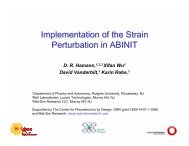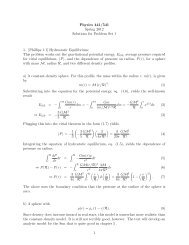7. Interference of Sound Waves
7. Interference of Sound Waves
7. Interference of Sound Waves
You also want an ePaper? Increase the reach of your titles
YUMPU automatically turns print PDFs into web optimized ePapers that Google loves.
2011 <strong>Interference</strong> - 1<br />
INTERFERENCE OF SOUND WAVES<br />
The objectives <strong>of</strong> this experiment are:<br />
• To measure the wavelength, frequency, and propagation speed <strong>of</strong><br />
ultrasonic sound waves.<br />
• To observe interference phenomena with ultrasonic sound waves.<br />
APPARATUS: Oscilloscope, function generator, ultrasonic transducers, meter stick,<br />
angle board.<br />
INTRODUCTION<br />
I<br />
n this experiment we deal with sound waves, produced by and detected with ultrasonic<br />
transducers. We study the interference <strong>of</strong> coherent (same phase) waves. The<br />
oscillations are displayed on an oscilloscope.<br />
Sinusoidal waves can be characterized by the following parameters:<br />
Wavelength: ...........................<br />
Frequency:..............................f
2011 <strong>Interference</strong> - 2<br />
Period: ....................................T = 1/f<br />
Wave propagation speed: ......c = f = /T .<br />
The speed <strong>of</strong> sound through air (at 20 C) is approximately 344 m/s.<br />
Ultrasonic transducer<br />
A transducer is a device that transforms one form <strong>of</strong> energy into another, for example, a<br />
microphone (sound to electric) or loudspeaker (electric to sound). In this experiment the<br />
transducer is a "piezoelectric" crystal <strong>of</strong> barium titanate which converts electrical<br />
oscillations into mechanical vibrations that make sound. The oscillating frequency is near<br />
40 kHz which is beyond what can be heard by the human ear (about 20 kHz).<br />
<strong>Interference</strong> <strong>of</strong> <strong>Waves</strong><br />
Below in Figure 1 is a drawing <strong>of</strong> the basic concept for interference <strong>of</strong> coherent waves<br />
from two point sources. Coherent means that the waves, even though they are from<br />
separate sources, have the same frequency and are in lock-step, namely in phase, as they<br />
are being emitted. The waves will get out <strong>of</strong> relative phase because they have to travel<br />
different path lengths to reach the same point in space. There, the waves can add<br />
constructively if they are in phase, or add destructively if they arrive out <strong>of</strong> phase. Look<br />
at the diagram.<br />
FIGURE 1<br />
S1 and S2 are sound wave sources oscillating in phase because they are driven by the<br />
same voltage signal generator; they are separated by distance d. The sources also emit<br />
waves <strong>of</strong> the same frequency. P is the place where we place a detector, fairly far (in terms
2011 <strong>Interference</strong> - 3<br />
<strong>of</strong> d) from S1 and S2 . At point P the path difference to S1 and to S2, is the distance<br />
d sin . When the path difference, d sin is an integral multiple <strong>of</strong> the wavelength ,<br />
waves arriving at P from S1 and S2 will be in phase and will interfere constructively.<br />
Note that constructive interference gives maximum intensity:<br />
d sin<br />
<br />
max<br />
n<br />
where n = 0, 1, 2,-- is referred to as the order <strong>of</strong> the particular maximum.<br />
The Oscilloscope<br />
We have used FFTscope, a virtual oscilloscope, in previous labs. If you're unfamiliar with<br />
the basic operation <strong>of</strong> a real oscilloscope the following should be helpful. Essentially, the<br />
amplitude <strong>of</strong> a quantity (usually Voltage) is plotted on the screen as a function <strong>of</strong> time, in<br />
real-time. It is possible to display one or two channels (quantities) at the same time; in<br />
this lab we monitor Driving Voltage from the transmitting transducer (via the function<br />
generator) and Induced Voltage in the receiving transducers. Here we will monitor the<br />
receiving transducer on Channel 1 (CH 1, yellow trace) and the transmitting transducers<br />
on Channel 2 (CH 2, blue trace).<br />
PROCEDURE:<br />
1. Learn to use the oscilloscope
2011 <strong>Interference</strong> - 4<br />
1. Position the oscilloscope in front <strong>of</strong> you. If you wish you can gently flip out the front<br />
legs so that it is tilted upward for easier viewing. Make sure no cables are plugged into<br />
the front <strong>of</strong> the scope for now (T-connectors are okay though). Press the ON button on<br />
the top left <strong>of</strong> the scope and wait 35-40 seconds for the grid to show on the display<br />
(ignore the Language selection screen). If the scope is already on, press the DEFAULT<br />
SETUP button on the upper-right.<br />
2. You should see two baseline “noise” traces – Yellow for CH1 and Blue for CH2; this<br />
is merely background noise since nothing is yet plugged into the scope.<br />
a. Experiment with adjusting the vertical position <strong>of</strong> both traces by adjusting the Vertical<br />
Position knobs above the CH1 Menu and CH2 Menu buttons – this will allow you to<br />
arrange your plots so that they are not on top <strong>of</strong> one another. There is also a Horizontal<br />
Position knob above the SEC/DIV knob. This allows one to move the traces left or right.<br />
b. Now fiddle with the Sec/Div knob – this sets the size <strong>of</strong> your time window (horizontal<br />
axis). If you set the value (look at the “M” value at the bottom-center <strong>of</strong> the screen) to<br />
something like 500ms, it'll look like one <strong>of</strong> those patient monitoring displays at the<br />
hospital. The M value is the time interval per square. Note that this scope will let you<br />
examine a time window on the order <strong>of</strong> a few nanoseconds – an extremely short<br />
interval <strong>of</strong> time.<br />
c. Restore the Sec/Div knob to some intermediate value and now adjust the Volts/Div on<br />
each channel – this adjusts the gain, or sensitivity <strong>of</strong> the trace on the vertical axis (i.e.<br />
potential difference per square). At the highest setting the traces will fluctuate wildly (but<br />
randomly); at the lowest setting they'll be relatively calm.<br />
2. Measuring frequency
2011 <strong>Interference</strong> - 5<br />
The setup is shown in Fig. 2 (note that Chnl B in the figure is Ch 2 on the oscilloscope,<br />
and Chnl A is Ch 1): a variable frequency signal generator drives one ultrasonic<br />
transducer; its output is also applied to channel 2 (blue trace) <strong>of</strong> the oscilloscope. (Later<br />
in the experiment two transmitting transducers will be connected to channel 2.) The<br />
output <strong>of</strong> a second receiving ultrasonic generator is applied to channel 1 (yellow trace) <strong>of</strong><br />
the scope. Channel 2 trace (pattern <strong>of</strong> the oscilloscope) shows the sinusoidal voltage<br />
applied to the transmitting generator; channel 1 trace shows the sinusoidal voltage<br />
coming out <strong>of</strong> the receiving ultrasonic crystal.<br />
Dual Trace<br />
Oscilloscope<br />
Chnl B<br />
Chnl A<br />
Function<br />
Generator<br />
Receiv er<br />
Transmitter<br />
FIGURE 2<br />
Plug the cables into the appropriate channels as pictured in Figure 2 above. Make sure<br />
that initially only one <strong>of</strong> the transmitting transducers is connected to the T-connector.<br />
Turn on the function generator by pressing the green power button.<br />
Adjust the scope controls: vertical amplification (Volts/Div), horizontal sweep rate<br />
(Sec/Div), vertical position, and horizontal position so that trace 1 shows several, steady<br />
sine curves. Place the transmitting transducer facing the receiver at a distance <strong>of</strong> a few<br />
centimeters. If you think the transducers are not functioning (nothing on trace 1), it is<br />
most likely that the function generator is not at the exact resonance frequency. You<br />
should tune to resonance when the signal getting through to the receiving transducer<br />
(trace 1) reaches a maximum. Do this by varrying the frequency around 38 to 42 kHz. Be<br />
aware that a small red light on the display <strong>of</strong> the function generator will light up “kHz” if<br />
the reading is in kHz (as opposed to Hz). This is, <strong>of</strong> course, what you want. You can see<br />
that sound signal is being received by placing your hand in front <strong>of</strong> the transducers. By<br />
blocking the sound wave, you will disturb or eliminate the yellow trace from Ch 1.
2011 <strong>Interference</strong> - 6<br />
Warning: Do not exchange your transducers with those from other tables;<br />
your three transducers are a matched set.<br />
Measure the period <strong>of</strong> oscillation directly from the oscilloscope's screen, taking into<br />
account the sweep rate (“M” value at bottom-center <strong>of</strong> screen). To make the period<br />
measurement as accurate as possible, measure the time interval corresponding to several<br />
complete oscillations. That is, measure the total time interval and divide by the total<br />
number <strong>of</strong> waves. Use the fine rulings <strong>of</strong> the square boxes to obtain a precise value. The<br />
reciprocal <strong>of</strong> T is f. Compare the frequency fo determined with the oscilloscope with both<br />
the frequency fsg <strong>of</strong> the signal generator and the frequency provide by the oscilloscope in<br />
blue in the lower right corner <strong>of</strong> the screen. The latter two values will likely be more<br />
accurate than your computed value, but the point is to gain an understanding <strong>of</strong> the<br />
information conveyed by the oscilloscope traces.<br />
A more precise way to measure the period, which exploits special features <strong>of</strong> the<br />
oscilloscope is as follows. Press the Cursor button near the middle <strong>of</strong> the dozen buttons<br />
at the top <strong>of</strong> the face <strong>of</strong> the scope – this will now change the on-screen Menu on the right<br />
<strong>of</strong> the scope screen. The Menu selections can be made by pressing on the buttons<br />
immediately to the right <strong>of</strong> the screen; press the button to the right <strong>of</strong> Type (twice) so that<br />
the Time cursors are activated. Beneath Type the word “TIME” will appear in a white<br />
box, and you should now see two vertical lines on the screen. If beneath Source you see<br />
“Ch 1” or “Ch 2” the vertical lines will be yellow or blue respectively. Either will do<br />
since both traces pertain to waves <strong>of</strong> the same frequency and period. However, if you see<br />
neither “Ch 1” nor “Ch 2” you will need to press the button to the right <strong>of</strong> Source until<br />
you are in one <strong>of</strong> these settings. Turn the knobs labeled VERTICAL Position CURSOR 1<br />
and CURSOR 2 (i.e. the knobs which usually move the traces the left and right) to move<br />
the vertical lines left and right. Align one with a wave crest (or trough) to the left <strong>of</strong> the<br />
screen and one with a wave crest (or trough) to the right <strong>of</strong> the screen. Then the read out<br />
on the right <strong>of</strong> the screen in blue or yellow will say DELTA beneath which will read the<br />
time interval between the vertical lines. This information can also be extracted from the<br />
difference in time values listed for Cursor 2 and Cursor 1 just below DELTA. You need<br />
only divide by the number <strong>of</strong> wave cycles in order to determine the period.<br />
3. Measuring wavelength<br />
The transmitting and receiving transducer stands fit over, and can slide along, a meter<br />
stick. With both transducers fixed in position, the two sinusoidal traces on the scope are<br />
steady. What happens to the scope trace from the receiving transducer when you move<br />
the receiving transducer away from the transmitting transducer? The traces are providing<br />
information about the relative phases <strong>of</strong> the transmitted and received sound wave (or the<br />
driving voltage and receiver voltage).<br />
Measure the wavelength by slowly shifting the receiving transducer a known distance<br />
away from the transmitter while noting on the oscilloscope screen by how many complete<br />
cycles <strong>of</strong> relative phase the wave pattern shifts. Don't choose just one cycle, but as many<br />
cycles as can conveniently be measured along the meter stick.
2011 <strong>Interference</strong> - 7<br />
4. Calculating Speed <strong>of</strong> <strong>Sound</strong><br />
Use the measured period <strong>of</strong> ultrasonic oscillations from Part 2 and the wavelength from<br />
Part 3 to compute the speed <strong>of</strong> sound through air. Then repeat the calculation using the<br />
frequency from the signal generator. The oscillation period measured with the scope<br />
sweep calibration may not be as accurate as the frequency readings on the signal<br />
generator or oscilloscope display. Compare your computed values with the standard<br />
value <strong>of</strong> 344 m/s for dry air at 20 C temperature. Then consider which is more accurate<br />
and why.<br />
5. Double Source <strong>Interference</strong><br />
The setup is similar to Fig. 2, but another transmitting transducer is added. This is<br />
effected by plugging the cable <strong>of</strong> the second transmitter into the T-connector and<br />
centering the pair <strong>of</strong> transmitters on the board (they are attached by a magnet at their<br />
base, which can slide). The pair <strong>of</strong> transmitters are placed side-by-side and driven in<br />
phase by a signal generator; a third receiving transducer is at an angle which can be<br />
varied. See Fig. 3, which duplicates the arrangement shown in Fig. 1.<br />
FIGURE 3<br />
We are interested in observing the amplitude <strong>of</strong> the resultant ultrasonic wave reaching the<br />
receiving transducer. When you move the detector you are receiving the combined<br />
intensity <strong>of</strong> the two interfering waves. Sometimes you will see a strong signal while other<br />
times little or none. Move the receiving transducer along a circular arc, maintaining a<br />
constant distance from the two transmitting transducers. Record the transmitter<br />
separation d and the angular positions max for interference maxima. The separation<br />
between transmitters should be kept as small as possible, while the distance <strong>of</strong> the<br />
receiver should be as large as possible. However, you may have to compromise on the<br />
inter-transmitter distance you choose since fewer maxima will be observable for smaller<br />
distances. For this reason, it may not be possible to see the fourth order maximum.<br />
Suggestion: rather than plotting max readings directly from the protractor, try taking<br />
corresponding left-side and right-side values and average them, thus eliminating any error<br />
in judging where the center line is.
2011 <strong>Interference</strong> - 8<br />
Confirm the constructive interference relation, n = d sinmax, by plotting sin max as a<br />
function <strong>of</strong> the integer n. (Take values for n and max on the right side as positive and<br />
those on the left as negative so your plot is a straight line (sin = -sin) rather than a<br />
"V"). The slope <strong>of</strong> your best straight line will enable you to calculate /d, and then the<br />
wavelength in terms <strong>of</strong> the measured distance, d, between the transmitters. Compare<br />
this with the value <strong>of</strong> measured in part 4. Obviously the slope will also give you d/.<br />
Thus you can find the separation d in terms <strong>of</strong> the theoretical wavelength = c/f.<br />
Compare this with the value <strong>of</strong> d directly measured.
2011 <strong>Interference</strong> - 9<br />
INTERFERENCE OF SOUND WAVES<br />
LAB REPORT FORM<br />
Name:___________________________________________________ Section:________<br />
Partner: _____________________________________________________Date: _______<br />
2) Frequency Measurement<br />
Oscilloscope Time Base Per Div (TB): __________<br />
Number <strong>of</strong> <strong>Waves</strong> Counted on Screen (NW):_________<br />
Number (& fractional parts) <strong>of</strong> Divisions Covered by <strong>Waves</strong> (ND): ________<br />
Period <strong>of</strong> One Wave = TB * ND / NW = _________ Frequency = _________<br />
Frequency from signal generator, = __________<br />
Frequency from oscilloscope display = __________<br />
3) Wavelength Measurement<br />
Number <strong>of</strong> <strong>Waves</strong> Moved on Oscilloscope Nw: _________<br />
Initial Position <strong>of</strong> Movable Sensor Pi: __________<br />
Final Position <strong>of</strong> Movable Sensor Pf: ___________<br />
Distance sensor moved, Pi - Pf = D: _____________<br />
Length <strong>of</strong> One Wave, Wavelength = D/Nw : ___________<br />
What happens to the scope trace from the receiving transducer when you move the<br />
receiving transducer away from the transmitting transducer? How does this allow you to<br />
calculate wavelength? Explain.<br />
4) Speed <strong>of</strong> <strong>Sound</strong>: Use your wavelength and frequency (as determined with<br />
oscilloscope) to calculate c. Do the same with the function generator frequency.<br />
c = = _____________ c = =_____________<br />
Compare your computed values with the standard value <strong>of</strong> 344 m/s for dry air at 20 C<br />
temperature. Which is better?
2011 <strong>Interference</strong> - 10<br />
5) <strong>Interference</strong> <strong>of</strong> <strong>Sound</strong> Separation <strong>of</strong> Sources, d: _________<br />
max sin(max) n (maximum #)<br />
Graph sin(max) vs. n. Measure slope <strong>of</strong> line fitted to data.<br />
slope = /d = ______ (recall, n = d sinmax)<br />
use measured d to get _____<br />
Compare wavelength measured on the oscilloscope (Part 3) with the value from<br />
interference (Part 5):<br />
R (ratio) = oscint = __________<br />
The slope <strong>of</strong> your best straight line also enables you to calculate (d/), and thus the<br />
separation d in terms <strong>of</strong> the theoretical wavelength = c/f. Use the theoretical value <strong>of</strong> c<br />
and the value <strong>of</strong> frequency which gave the most accurate speed in part 4 to compute<br />
lambda. Compare this with the value <strong>of</strong> d directly measured.


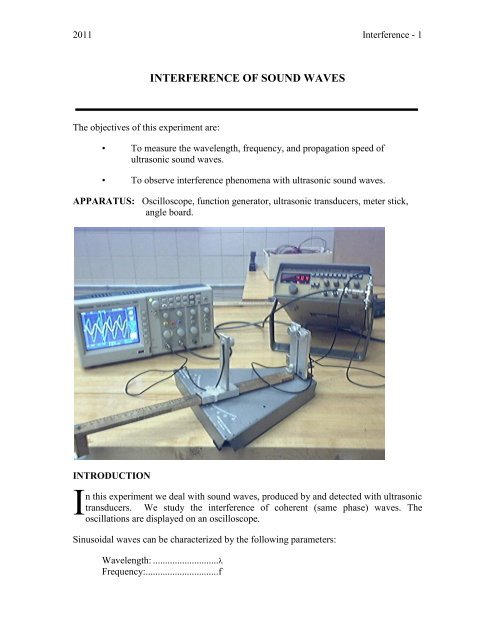
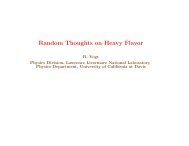

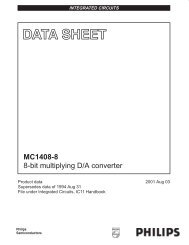

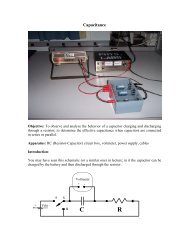


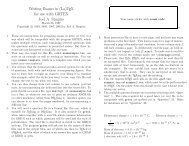
![More Effective C++ [Meyers96]](https://img.yumpu.com/25323611/1/184x260/more-effective-c-meyers96.jpg?quality=85)

